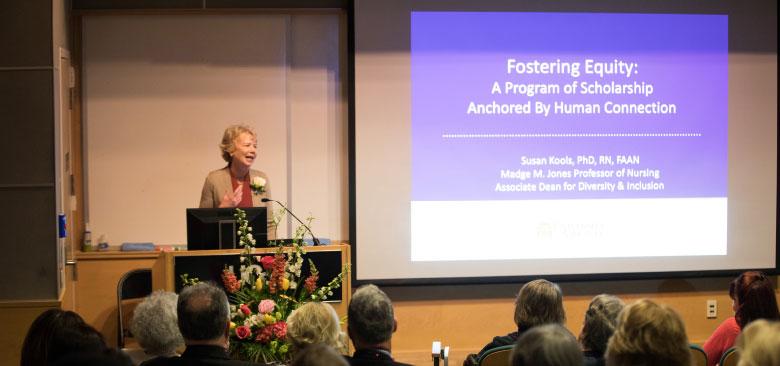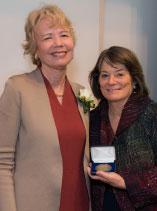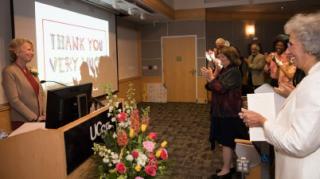
Susan Kools' lecture covered her program of research and her work to increase diversity and equity in nursing education (photos by Elisabeth Fall).
Susan Kools Gives 38th Helen Nahm Research Lecture
On May 31, 2018, Professor Emerita of Family Health Care Nursing Susan Kools, currently Madge M. Jones Professor of Nursing and associate dean for Diversity and Inclusion at the University of Virginia (UVA) School of Nursing, was honored as the 38th Helen Nahm Research Lecturer. In her lecture, Kools shared insights gained over 30 years of work as a child and adolescent psychiatric nurse-scientist. Her work with young people who experience vulnerability, marginalization by others and health inequities – and her position as a champion for inclusion and equity in nursing education – has a common thread, emphasized throughout the lecture: human connection.
Kools, the first member of her family to graduate from high school, spoke of how as a student nurse in Wisconsin, she met patient Floyd White Eagle, chief of the Winnebago Tribe of Wisconsin, who led her to confront her privilege as a white woman. “Floyd taught me about the social determinants of health before it was a term and taught me cultural humility before I had the language for it,” Kools said.
That connection set Kools on a path working with some of society’s most vulnerable members. After receiving her MSN degree from UCSF in 1984, Kools began working with adolescents living in foster care, which spurred her interest in the lived experiences of these young people and how those experiences intersected with health. Thus began a research career that was unusual for the time. “Nurses didn’t do this kind of work,” she said. “No one had queried adolescents themselves about their experiences, so that’s where I started.”
Listening to Foster Youth
Kools described how one of her early research projects was a grounded theory study on perceptions of growing up in foster care in which Kools visited several group homes for foster youth. She found highly institutionalized environments – locks on refrigerators, rigid rules governing individual behavior – that reinforced stereotypical views of foster youth as mentally ill or “bad,” and contributed to stigmatized self-identity and internalized negative views.
Kools found that the adolescents in the study experienced a variety of negative outcomes, including social isolation, lack of future orientation and the inability to live independently. She said, “It illustrated the need to reframe how foster youth are perceived – to shift focus to strengths and resilience.”
As a result of the study, Kools and her team made recommendations for more extensive training for caregivers to help them differentiate normative behavior from behavior resulting from adverse childhood experiences, and to help them handle the latter therapeutically rather than punitively, a precursor to today’s trauma-informed care model.
She said that a subsequent grant from the California Wellness Foundation allowed Kools, in partnership with the late Alan Watahara, then director of the California Partnership for Children, to analyze the policy needs of California adolescents aging out of foster care.
Using interpretive policy analysis to analyze public documents, data from caregivers, and the findings of focus groups with then-current and former foster youth, they found that transitioning youth had some of the worst social outcomes:
- 50 percent didn’t complete high school.
- 25 percent were homeless within the first year of aging out.
- 50 percent were unemployed at age 24.
- 10 percent of women and 27 percent of men ended up incarcerated at some point.
- Most had mental health problems, such as post-traumatic stress disorder (PTSD).
Based on these findings, Kools and Watahara made policy recommendations that resulted in new legislation in California, including earlier and enhanced independent living preparation, job-skills training and assignment to a consistent case manager to help youth navigate the transition to adulthood.
This work also led to a National Institute of Nursing Research (NINR)-funded study, the Foster Youth Project, which Kools led with a team of UCSF researchers, including former Dean Jane Norbeck, Steve Paul, Erica Monasterio, Bridget Gramkowski, Aara Amidi-Nouri, Nancy Robbins, Rasheda Jones and Cynthia Wei. The mixed-methods study tested an intervention that paired advanced practice adolescent health nurses with court-appointed special advocates (CASAs), specially trained volunteers who sustain mentoring and advocacy relationships with children in foster care. The nurses in the study regularly consulted with the CASAs to improve their understanding of the health and developmental issues of their adolescent clients.
 Dean Catherine L. Gilliss presents the Helen Nahm Award to Susan Kools. Despite difficulties with retaining study participants and with data collection and analysis, the findings were interesting, Kools said. There were stark differences between the self-reported health of the adolescents and what CASAs reported to nurses. While 40 percent of the study adolescents reported “excellent health,” most CASAs reported serious problems in the youths they worked with, such as poorly treated chronic health conditions, mental health issues and school and social problems, mirroring reports from the scientific literature.
Dean Catherine L. Gilliss presents the Helen Nahm Award to Susan Kools. Despite difficulties with retaining study participants and with data collection and analysis, the findings were interesting, Kools said. There were stark differences between the self-reported health of the adolescents and what CASAs reported to nurses. While 40 percent of the study adolescents reported “excellent health,” most CASAs reported serious problems in the youths they worked with, such as poorly treated chronic health conditions, mental health issues and school and social problems, mirroring reports from the scientific literature.
Kools wasn’t especially surprised. “I had seen this in my earlier studies,” she said. “Foster youth engage in a special kind of social desirability and often paint positive pictures of their health and mental health as a self-protective behavior to avoid stigma and placement or school transition.”
Investigators also found that youths who reported more risky behaviors, including substance use and unprotected sex, were at highest risk for poor health outcomes. Girls appeared to be especially vulnerable.
While the outcomes for adolescents in the study didn’t reach statistical significance – possibly due to overinflation of health status at baseline, Kools noted – the intervention proved effective for the CASAs, who reported highly valuing the consultation sessions with the nurses and who were less likely than nurses in the control group to leave the program and sever important social ties with the adolescents they worked with.
The CASAs also learned to distinguish between normative and worrisome behaviors and learned concrete strategies to help the adolescents they worked with. They also engaged in more health-targeted advocacy, including following up on chronic conditions and medication issues and seeking referrals for mental health or school problems.
Working with Adolescents to Prevent HIV in Africa
Kools’ work with vulnerable children has been global in scope, and she spoke of traveling to Hong Kong to study psychosocial functioning among hospitalized Chinese children and adolescents, among other projects.
In 2006, Kools said, global health nurse-researcher (and 35th Nahm Lecturer) Sally Rankin invited Kools to join a team studying religious leaders’ influence on human immunodeficiency virus (HIV) prevention and treatment in sub-Saharan Africa, where, she said, 40 percent of new HIV infections occur in people between the ages of 15 and 24 years.
In Malawi, which has one of the world’s highest rates of HIV infection, the team did a pilot study of a developmentally appropriate, culturally tailored prevention program for young adolescents that utilized college students who had grown up in similar rural villages. In addition to providing age-appropriate education, the college students played with the children to promote social connectedness, a demonstrated protective factor in HIV prevention. The intervention was shown to be both feasible and acceptable, and demonstrated that “having a sustained relationship with a thriving young adult to look up to and, perhaps, emulate showed promise [in HIV prevention],” Kools said.
Kools is conducting a similar project in Uganda, working with Viola Nyakato, a sociologist who directs the Institute of Interdisciplinary Research and Training at the Mbarara University of Science and Technology. The research is an anchor project of the UVA Minority Health International Research Training Program (UVA MHIRT), funded by the National Institute on Minority Health and Health Disparities. With UVA colleagues Rebecca Dillingham and Jeanita Richardson, Kools is co-investigator of UVA MHIRT, which provides underrepresented students from around the United States with intensive, mentored research experience in global settings.
Kools’ current MHIRT project uses a pair of participatory research methods, photovoice and community mapping, to understand influences on sexual development and risk among 10- to 14-year-olds. Photovoice allows research participants to use photography to capture visual representations of their everyday lives, providing researchers with insights into a community that may be wary of outsiders and prompting critical dialogue around a research issue. Community mapping is a visual strategy that allows young community members with limited literacy to visually depict data that represent what is happening in their community.
The team has also interviewed community leaders and held focus groups on these themes with parents and young adults. A community advisory board is helping the team develop and tailor an intervention to meet the community’s needs surrounding early adolescent sexuality.
Fostering Equity in Nursing Education
Kools noted that, throughout her career, she has been committed to building capacity in adolescent research through mentoring, telling the audience, “I think we can all agree that not one of us can singularly move the science in our given areas. We need to teach and influence others to expand the work.”
Kools’ work has always, directly or indirectly, focused on equity, diversity and inclusion, and she credits two of her mentors, Michael Adams and Howard Pinderhughes, with helping her come to a greater understanding of these issues: “Over the years, they have guided me on issues of race and equity and so many other things, and they still support me today.”
Former Dean Jane Norbeck founded the School’s Diversity in Action (DIVA) committee, which strives to create a welcoming, inclusive and respectful community for students, faculty and staff and which Kools co-chaired, first with Pinderhughes for a decade, then with Erica Monasterio, for four more years. Her time on the committee saw the development of some of its signature programs, including training modules to enhance faculty skills to address issues of difference in the classroom, create inclusive and respectful learning environments, and apply the HEALS model, which is an active strategy to confront microaggressions and unconscious bias.
Kools has used her experiences with DIVA as the foundation for her work at UVA. As associate dean for Diversity and Inclusion, she has modeled some of her program on the work done at UCSF, leading the UVA School of Nursing’s Inclusion, Diversity and Excellence Achievement (IDEA) initiative. She noted that IDEA is based on four central questions: “Who gets to learn and work here? How do we want to engage with one another? What is the philosophy underlying all that we do here? What is the legacy we leave?”
 Kools spoke of the challenges that have recently faced both the nation and UVA specifically, including an increase in discriminatory behavior by patients and families at the UVA Medical Center and, notably, the aftermath of the “Unite the Right” white nationalist rally at the UVA campus in Charlottesville. “Never in my wildest dreams did I imagine having neo-Nazis, the Klan and self-appointed militia, who were better armed and organized than the police, come to my home [city],” she said.
Kools spoke of the challenges that have recently faced both the nation and UVA specifically, including an increase in discriminatory behavior by patients and families at the UVA Medical Center and, notably, the aftermath of the “Unite the Right” white nationalist rally at the UVA campus in Charlottesville. “Never in my wildest dreams did I imagine having neo-Nazis, the Klan and self-appointed militia, who were better armed and organized than the police, come to my home [city],” she said.
The UVA School of Nursing, she said, took a different approach than the UVA administration in general, acknowledging and highlighting the problems of racism and anti-Semitism that still flourished in their midst. As she told the audience, “We confronted our ‘Tale of Two Cities’ – of white faculty and staff in our town hall meetings crying out, ‘This is not my Charlottesville, this is not my UVA!’ while faculty of color bravely said, ‘Well, actually, for us, it is.’”
Kools added that the crisis has invited a certain amount of introspection at the university, noting that the UVA School of Nursing is working with Shaun Harper, director of the Race and Equity Center at the University of Southern California, to build racial literacy at all levels of the organization, beginning with an eight-week intensive program that will be attended by the school’s dean’s council, program directors and other leaders.
Kools summed up by telling the audience that “fostering equity is a moral imperative in health care and in education.… We must persist, keeping the human faces of our work – our participants, our patients, our students – always at the forefront of what we do.”



